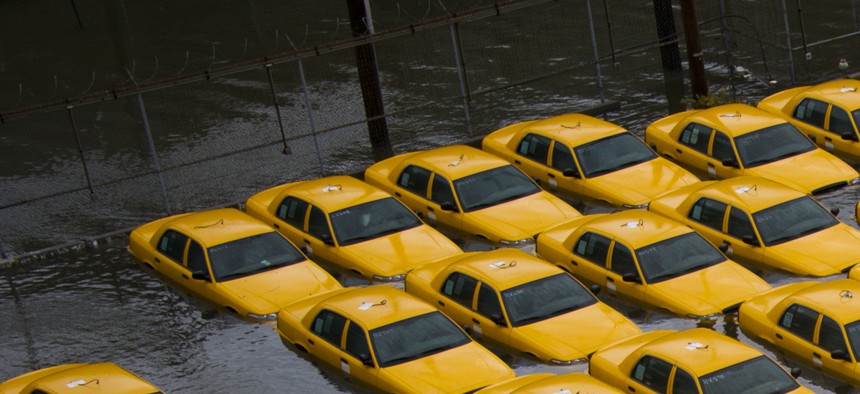The Water Next Time

A taxicab parking lot in Hoboken, N.J., was submerged during Superstorm Sandy in 2012. Charles Sykes / AP File Photo
In Hoboken, N.J., nature itself could become the city’s best defense against extreme weather.
As we drove downhill along narrow Second Street in Hoboken, the compact New Jersey city separated from Manhattan by the Hudson River, the landscape and urban designer Diana Balmori remarked to me that after Hurricane Sandy, this part of town had basically been “a lake.” During Sandy’s storm surge, in October 2012, river water breached the town’s northern and southern tips and spilled into its low areas. On the west side of the city, still more water tumbled down the Palisades, the steep cliffs that run along the Hudson River. Only the highest part of Hoboken stayed dry, as if treading water in the lake that Balmori described. “It took a month to get rid of some of the water,” she said.
When the water was finally gone, so too were any doubts about the threat climate change might pose to the region. “Before, everybody thought, Well, who knows if this whole thing of global warming is happening?” she said. “There was such conviction after Sandy.”
In one measure of that conviction, the U.S. Department of Housing and Urban Development launched a giant, federally funded competition called Rebuild by Design, aimed at protecting areas battered by Sandy from future extreme weather. Which is how Balmori and her colleague Javier González-Campaña came to collaborate with the architecture firm (and project lead) OMA, the Dutch engineering consultancy Royal HaskoningDHV, and the economic strategists at HR&A Advisors on a plan to prepare Hoboken for future flooding. In June, when HUD parceled out nearly $1 billion among six winners, the Hoboken project received $230 million.
An island in the days of Henry Hudson, Hoboken put itself at odds with the river that bears the explorer’s name by filling in and building on the marshlands that once surrounded it. The city is the fifth-densest in the country, with some 50,000 residents stuffed into little more than a single square mile. Sandy flooded more than 1,700 Hoboken homes, knocked out the city’s power grid, and halted trains into New York; in total, the storm caused more than $100 million in damages. “It filled up Hoboken like a bathtub,” Mayor Dawn Zimmer told me when I visited her at city hall. Two years after the hurricane, Hoboken remains susceptible even to lesser storms; Zimmer explained that half a dozen significant floods have hit the city since Sandy. I asked her when Hoboken would ideally have a storm system in place. “Tomorrow,” she said, moments after an aide joked, “Yesterday.”

Hoboken, N.J., as seen from the Hudson River. (Photo by cdrin / Shutterstock.com)
The team calls its plan “Resist, Delay, Store, Discharge,” and it intends to reduce local vulnerability to water in just the ways the name suggests. Flood walls strong enough to resist storm surges will protect high-risk sites along the riverfront. A system of parks, so-called green roofs, and terraced wetlands will hopefully act like sponges, soaking up water long enough to delay runoff and keep drains and sewers from being overwhelmed; another system of underground cisterns and retention basins will store excess water until high tides recede. Pumps will discharge floodwater back into the river once a storm has passed. Together, these parts should be capable of withstanding a once-in-500-years storm. What makes the plan so innovative, says Daniel Pittman, an architect and strategist at OMA and the overall lead for the design team, is that it doesn’t rely on one isolated tool for defense but instead weaves together “hard” infrastructure (like levees) with “soft” infrastructure (like parks).
This combination of tactics reflects a new approach to water management for coastal cities, one embraced most notably by the Dutch. Decades ago, the Netherlands—much of which is at or below sea level—built a vast system of dams, levees, and other hard barriers to protect against the North Sea. But as sea levels rose, and as major storms exposed the limitations of such structures, water experts realized the need for a change. Indeed, Mayor Zimmer told me that a recent visit to Rotterdam left her thinking that the Dutch had learned more than Americans had from storms like Katrina. Instead of continuing to bank on the idea of keeping water out, the Dutch have begun to create a sort of partnership with the sea, inviting a certain amount of flooding into trenches and urban parks.
A combined hard-and-soft approach seems well suited for Hoboken, which wants to maintain a close relationship with the river while still protecting residents from tides and storm surges. “The Hudson River is a danger for us, but most importantly, it’s a treasure to Hoboken,” Zimmer told me. “If you’re literally just blocking off the river, not only are you hurting the quality of life, you’re potentially impacting the economy of our city as well.”
Read the complete story in the December 2014 issue of The Atlantic ...





